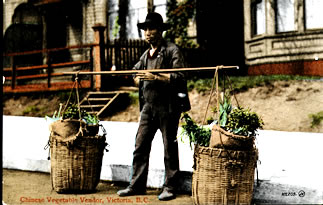
Lesson Fifteen: Industrialization, Class, and Race;
Chinese and the Anti-Chinese Movement
in the Late 19th-Century Northwest
Chinese vegetable vendor, Victoria, B.C., (left). (Special Collections, University of Washington Libraries, Social Issues Files Cb, UW negative #514)
Railroads and industrialism changed the Pacific Northwest economy not only by accelerating and mechanizing the extraction of natural resources but also by accentuating divisions between classes and races. Business interests, led by railroad and timber barons, formed elites that dominated industries, towns, and politics; workers organized to protect and assert the interests of labor. The result, particularly in Washington and Idaho, was a considerably polarized society that featured an unusually high degree of labor radicalism between 1880 and 1920. (In his textbook and other works, Carlos Schwantes has written a good deal about this aspect of regional history.) But conflict did not occur solely between classes. Within the working classes there emerged additional divisions defined by race.
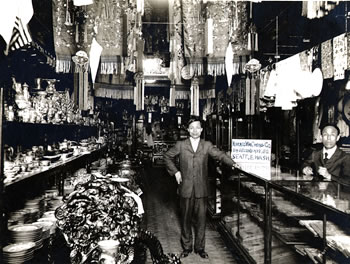 The economy of the American West was characterized by a dual labor system. Whites occupied the majority of the white-collar and skilled blue-collar positions. They also occupied semi-skilled and unskilled positions, but enjoyed higher rates of mobility out of those kinds of jobs. People of color, on the other hand, occupied in disproportionate numbers the semi-skilled and unskilled positions at the bottom of the economic ladder. These workers—Indians, blacks, and people of Mexican and Asian descent—had fewer chances to escape the lower rungs (although in some cases members of minority groups owned and operated their own businesses). When white workingmen formed into unions in the American West, they often were organizing not only against capital but also against the non-white worker who, in a variety of ways, was perceived as a threat to whites' economic security. In the Pacific Northwest of the 1880s—the very decade when railroads increased the pace of industrialization in the region—these patterns of labor organization and conflict played out against Chinese communities.
The economy of the American West was characterized by a dual labor system. Whites occupied the majority of the white-collar and skilled blue-collar positions. They also occupied semi-skilled and unskilled positions, but enjoyed higher rates of mobility out of those kinds of jobs. People of color, on the other hand, occupied in disproportionate numbers the semi-skilled and unskilled positions at the bottom of the economic ladder. These workers—Indians, blacks, and people of Mexican and Asian descent—had fewer chances to escape the lower rungs (although in some cases members of minority groups owned and operated their own businesses). When white workingmen formed into unions in the American West, they often were organizing not only against capital but also against the non-white worker who, in a variety of ways, was perceived as a threat to whites' economic security. In the Pacific Northwest of the 1880s—the very decade when railroads increased the pace of industrialization in the region—these patterns of labor organization and conflict played out against Chinese communities.
Chin Fook Hing (right) was a Chinese importer in Seattle. This 1909 photograph shows him in his shop, located at 114 Second Avenue. (Special Collections, University of Washington, Social Issues Files Cb, neg. 420)
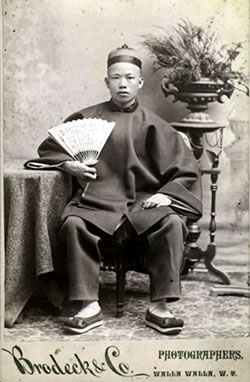 Chinese migrants (left) lived throughout Washington, as this Walla Walla portrait of a Chinese youth documents. (Special Collections, University of Washington, Social Issues Files Cb.)
Chinese migrants (left) lived throughout Washington, as this Walla Walla portrait of a Chinese youth documents. (Special Collections, University of Washington, Social Issues Files Cb.)
Streams of emigrants began leaving China, mainly for other parts of Asia, during the late 18th century. The great majority regarded themselves as sojourners, i.e. people who intended to return to China rather than settle permanently in the places to which they had moved. During the 1840s, as the Chinese empire collapsed under pressures imposed by other nations, rapid population increase, declining standards of living, and problems in government, Chinese sojourners began moving to the New World, and particularly to California where the gold rush had attracted the attention of migrants from around the globe. Between 1849 and 1882, approximately 300,000 Chinese entered the United States. Many entered more than once, taking return trips to China; others left and never returned. As a result, the 1880 census counted only about 100,000 Chinese in the U.S. The ratio of men to women among these immigrants was about 20 to 1. As late as 1920, women still amounted to less than fifteen percent of all people of Chinese descent in the U.S.
Chinese immigrants worked primarily as laborers and lived largely in the states and territories of the American West. Most toiled at mining and constructing railroad lines across the region, and they also worked in agriculture. Some worked at providing services to other Chinese people, particularly those concentrated in Chinatown districts in western cities. Opportunities were limited by racism and segregation. Because American jobs generally paid better than the employment that cold be had in China, Chinese sojourners generally earned enough money to make immigration worthwhile (although many never acquired enough savings to be able to afford to return to China). However, with the exception of a few businessmen operating in Chinatowns, none had good access to paths of upward mobility within the American economy. The Chinese were paid lower wages than white workers, and they suffered other forms of economic and civil discrimination which were based in part on racism against Asians and in part on fear of the Chinese as economic competitors. Yet the demand for labor in the American West during the later 19th and early 20th centuries was generally high, and for this reason Chinese (as well as Japanese and Mexicans and Filipinos) were routinely recruited and employed.
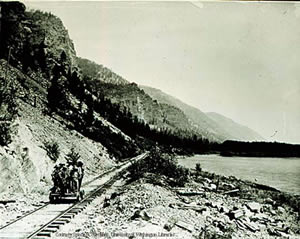 Chinese laborers (right) working on the Northern Pacific Railroad tracks along the Columbia River gorge. (Special Collections, University of Washington, Social Issues Files Cb, neg. 522.)
Chinese laborers (right) working on the Northern Pacific Railroad tracks along the Columbia River gorge. (Special Collections, University of Washington, Social Issues Files Cb, neg. 522.)
Beginning in the early 1850s in California, and then continuing in other times and places in the West, white workingmen protested that the Chinese drove down wages. White labor criticized the Chinese for accepting lower rates of pay, and criticized employers who hired the Chinese instead of whites. The animus against the Chinese and their employers grew strongest in times of economic downturns, such as during the mid-1870s and mid-1880s, when many Chinese workers involved in railroad construction were laid off. In California during the later 1860s and the 1870s, white workingmen took the lead in organizing an anti-Chinese movement in politics and within unions. The state and its cities passed a number of laws to discourage more Chinese from coming and to drive out those who were already there. Through mobs, lynchings, and other forms of violence, Chinese workers were also terrorized. Both the violence and the organizing spread across the West and to the entire country. During the later 1870s, both the Democratic and Republican party platforms contained anti-Chinese clauses. By 1882, the pressure against the Chinese resulted in passage of legislation outlawing the immigration of most Chinese into the United States. The act was designed primarily to exclude laborers; merchants, diplomats, students, teachers, and travelers were permitted to enter the country. But the drop-off in immigration was sizable. In 1881, 12,000 Chinese had entered the U.S.; in 1887, 10 Chinese did. (Over time, immigrants figured out how to use loopholes in the law to gain admission, so between 1882 and 1917 another 92,000 Chinese actually arrived.)
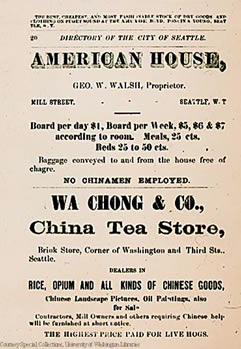 The Chinese Exclusion Act was the first major piece of legislation restricting immigration to America. It is noteworthy that Asians were the initial group to be singled out for discriminatory treatment in immigration policy, as well as the only peoples to be entirely excluded from immigration to the U.S. On top of this, until the early 1950s, Asians were the only immigrants who could not be naturalized as American citizens. Such draconian restrictions were entirely out of proportion to the relatively low numbers of Asians in the American population.
The Chinese Exclusion Act was the first major piece of legislation restricting immigration to America. It is noteworthy that Asians were the initial group to be singled out for discriminatory treatment in immigration policy, as well as the only peoples to be entirely excluded from immigration to the U.S. On top of this, until the early 1950s, Asians were the only immigrants who could not be naturalized as American citizens. Such draconian restrictions were entirely out of proportion to the relatively low numbers of Asians in the American population.
Passage of the 1882 Exclusion Act skewed the population of Chinese in the United States. It inhibited the predominantly male population from bringing wives from China, and thus greatly limited the immigrants' ability to reproduce themselves in the U.S. or to live with their families. Most immigrants' family members stayed in China. The Chinese community in the U.S. remained heavily male, and over time it aged markedly and declined in size. These demographic traits further marked off a population that was already quite distinctive, that already tended to cluster in homogeneous enclaves around the West, and that was discouraged by white discrimination as well as by a sojourners' orientation from undergoing substantial acculturation. In stark contrast to most immigrants groups in the U.S., the Chinese population declined sharply, from roughly 105,000 in 1882 to 62,000 in 1920. One can track this decline in the three states of the Pacific Northwest.
Contrasting advertisements, (left): According to Murray Morgan in Skid Road, "Wa Chong & Co. began manufacturing `Havana Cigars' in Seattle on February 1, 1883. Theirs was the first cigar factory on the Sound.... During the anti-Chinese agitation, a white label on the cigar meant only Caucasian workers were employed...." (Seattle, 1982 ed., p.120. Reproduction from City of Seattle Directory. Special Collections, University of Washington, Social Issues Files Cb, neg. 539)
Chinese Population in the Pacific Northwest (right) |
|
Class and racial tensions erupted during the mid-1880s in Oregon, Washington, and Idaho, as the Northern Pacific Railroad reached completion and laid off its construction workers-both white and Chinese. The Pacific Northwest entered a steep recession, and laborers streamed into cities looking for jobs, which proved quite elusive. In these conditions, the Chinese quickly became scapegoats for the economic distress of whites, who believed that the immigrants were taking away jobs that the whites rightfully deserved, and were also accepting lower wages which undercut non-Chinese workers. The anti-Chinese movement in the Northwest was spearheaded by members of the Knights of Labor, a fairly radical union whose leaders had already gained experience in the anti-Chinese movement in California during the 1870s. The Knights and other workers protested what they regarded as lax enforcement of the 1882 Exclusion Act. If the law was truly being upheld, they believed, there would not be so many Chinese available to take work. Moreover, workers complained about big regional employers, such as railroads, which had recruited, paid, and then laid off the Chinese in the first place. Big corporations were regarded as an important part of the economic problems, and not solely because of their relationship to the Chinese. Throughout the Northwest, the Knights tried to get workers to redirect anti-Chinese sentiments against the "capitalists, bankers, [and] railroad monopolists" who, the union charged, prevented less wealthy people from achieving upward mobility in the region.
Tacoma's "Committee of Fifteen," (below) who were in charge of organizing the expulsion of the Chinese in 1885, included among its members some of the city's most prominent businessmen. One of them, James Wickersham, went on to become a federal judge. (Special Collections, University of Washington, Social Issues File Cb, neg. 1679.)
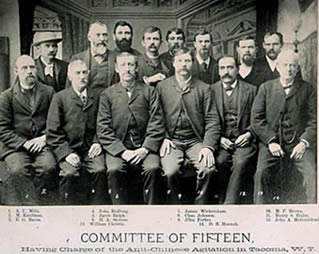 The anti-Chinese fervor crested between September 1885 and February 1886 in a series of violent attacks on immigrants. White miners, led by the Knights of Labor, killed 28 Chinese and wounded at least 15 others in Wyoming, in September, after a dispute over whether whites or Chinese would be assigned to an especially promising section of a coal mine owned by the Union Pacific Railroad. The "Rock Springs Massacre," as the event was named, touched off additional outbreaks of anti-Chinese violence. Near present-day Issaquah, Washington, a band of whites and Indians killed three Chinese hop-pickers the same month by setting their sleeping barracks afire, and another mob burned down the sleeping barracks of 36 coal miners near Newcastle, Washington. Sensing an opportunity to expand their organization, the Knights of Labor stepped up criticisms of the Chinese and their employers, and focused new attention on Tacoma.
The anti-Chinese fervor crested between September 1885 and February 1886 in a series of violent attacks on immigrants. White miners, led by the Knights of Labor, killed 28 Chinese and wounded at least 15 others in Wyoming, in September, after a dispute over whether whites or Chinese would be assigned to an especially promising section of a coal mine owned by the Union Pacific Railroad. The "Rock Springs Massacre," as the event was named, touched off additional outbreaks of anti-Chinese violence. Near present-day Issaquah, Washington, a band of whites and Indians killed three Chinese hop-pickers the same month by setting their sleeping barracks afire, and another mob burned down the sleeping barracks of 36 coal miners near Newcastle, Washington. Sensing an opportunity to expand their organization, the Knights of Labor stepped up criticisms of the Chinese and their employers, and focused new attention on Tacoma.
White Tacomans had expressed concern over the Chinese population prior to the fall of 1885. Newspaper accounts had for months attacked the Chinese as sub-human and blamed them for virtually all the city's problems. One newspaperman wrote:
Why permit an army of leprous, prosperity-sucking, progress-blasting Asiatics befoul our thoroughfares, degrade the city, repel immigration, drive out our people, break up our homes, take employment from our countrymen, corrupt the morals of our youth, establish opium joints, buy or steal the babe of poverty or slave, and taint with their brothels the lives of our young men?...If no other method of keeping them at a distance from our people can be found, let the citizens furnish them with lots on the waterfront, three fathoms below low tide.
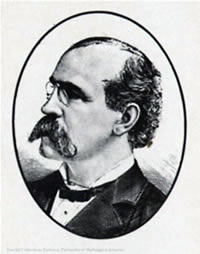 These sentiments, echoed in some Seattle newspapers, were accompanied by attempted boycotts against the Chinese. Some businesses hoped to attract more customers by advertising that they employed no Chinese. Some opponents of the Chinese set up a laundry run by white women, so that customers would not have to take their cleaning to immigrants shops (the white women's operation failed). Occasionally, anti-Chinese protesters targeted big corporations as well; one critic denounced railroad companies as "ironclad monopolies" and "the thieves who stole our timber and coal lands"—a reference to railroad's control over so much land in Washington. But in truth the Chinese—who were not, and could not become, citizens—made the far easier target.
These sentiments, echoed in some Seattle newspapers, were accompanied by attempted boycotts against the Chinese. Some businesses hoped to attract more customers by advertising that they employed no Chinese. Some opponents of the Chinese set up a laundry run by white women, so that customers would not have to take their cleaning to immigrants shops (the white women's operation failed). Occasionally, anti-Chinese protesters targeted big corporations as well; one critic denounced railroad companies as "ironclad monopolies" and "the thieves who stole our timber and coal lands"—a reference to railroad's control over so much land in Washington. But in truth the Chinese—who were not, and could not become, citizens—made the far easier target.
In October, the protest leaders announced that all Chinese would have to leave Tacoma by the start of November. Many Chinese departed, but some did not, so early in November a mob of whites, led by Tacoma's mayor and supported by the city police, invaded Tacoma's Chinatown and ordered its residents out of the city. The Chinese were marched to a railroad depot and put aboard a train to Portland. Few whites were willing to resist the mob. Most disapproved of the Chinese, and perhaps the only qualm they had was that the eviction by the mob seemed likely to stain Tacoma's reputation among prospective investors and immigrants back East.
Terence Powderly, (right). Leader of the Knights of Labor. In the 1880s, Powderly (1849-1924), became the most influential labor leader in the United STates when he organized the Knights of Labor as an industrial union with open membership and created a "job conscious" approach to trade union problems. (Special Collections, University of Washington, Social Issues Files Dc/i.)
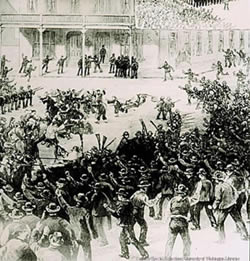
Seattle's anti-Chinese riot of February 8, 1886 (left), in front of the New England Hotel on Main & 1st Ave. Reproduction of a drawing in Harpers Weekly. Special Collections, University of Washington, Social Issues Files Cb, neg. 527)
In Seattle, a similar scenario unfolded early in 1886. Labor leaders had told the Chinese that they would have to leave the town. Some Chinese complied with the "order," but as many as 500 did not, and they remained behind. On the morning of February 7, a mob led by workingmen went to Chinatown, rounded up the remaining immigrants, marched them to the docks, and tried to put them aboard a waiting steamer. This time, however, the anti-Chinese forces encountered opposition from other whites, who protested this extra-legal action. Some businessmen in Seattle had spoken against the anti-Chinese movement among workers, seeing it in part as an issue of whether capital had the right to employ whoever it wanted to hire. Other businessmen objected to the show of strength by radical labor, and also opposed the extra-legal means adopted to evict the Chinese. They worried about Seattle's reputation. Few who resisted the anti-Chinese forces spoke up to defend the rights of the Chinese; their main focus seemed to be to find a way to remove the Chinese from the city legally. In any case, a misunderstanding developed between the more working-class people trying to remove the Chinese immediately, and the more middle-class people supporting "law and order" and opposing the unlawful expulsion of the immigrants. The middling sorts had organized into a militia called the "Home Guards," and in the midst of a confused confrontation over the fate of Seattle's Chinese these troops fired upon the working-class mob, killing one and wounding four. By March, the entire Chinese population of Seattle had been expelled. (The Chinese, nonetheless, reappeared in time to help the city rebuild after the 1889 fire.)
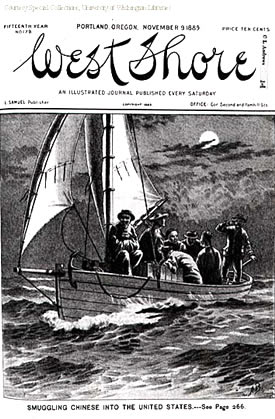 The anti-Chinese movement affected Oregon, too. Once more, mobs led by workers drove Chinese laborers out of small towns and selected workplaces, and in general terrorized the immigrants from Asia over a period of several months between the winter and summer of 1886. Most of the displaced Chinese went to Portland's Chinatown where, in part because of the city's close commercial and shipping ties to China, they were not expelled. Oregon added another twist to workers' sentiments against the Chinese. In addition to white men complaining of the competition they faced from Chinese workers, a number of white working women also took up the anti-Chinese cause. Women laborers often competed directly against Chinese men for jobs in domestic service, tailoring, laundries, and mills, and they joined in the white men's refrain that Asian immigrants were undermining their opportunities. With the decline of mining and the completion of railroad construction, the Chinese increasingly took jobs that had been regarded as within the "sphere" of women. One newspaper thus blamed the Chinese competition for driving white women out of respectable jobs and into careers of "depravity," i.e. prostitution. It was not just men, then, who perceived the Chinese as a threat. [See Margaret K. Holden, "Gender and Protest Ideology: Sue Ross Keenan and the Oregon Anti-Chinese Movement," Western Legal History 7 (Summer/Fall 1994):223-43.]
The anti-Chinese movement affected Oregon, too. Once more, mobs led by workers drove Chinese laborers out of small towns and selected workplaces, and in general terrorized the immigrants from Asia over a period of several months between the winter and summer of 1886. Most of the displaced Chinese went to Portland's Chinatown where, in part because of the city's close commercial and shipping ties to China, they were not expelled. Oregon added another twist to workers' sentiments against the Chinese. In addition to white men complaining of the competition they faced from Chinese workers, a number of white working women also took up the anti-Chinese cause. Women laborers often competed directly against Chinese men for jobs in domestic service, tailoring, laundries, and mills, and they joined in the white men's refrain that Asian immigrants were undermining their opportunities. With the decline of mining and the completion of railroad construction, the Chinese increasingly took jobs that had been regarded as within the "sphere" of women. One newspaper thus blamed the Chinese competition for driving white women out of respectable jobs and into careers of "depravity," i.e. prostitution. It was not just men, then, who perceived the Chinese as a threat. [See Margaret K. Holden, "Gender and Protest Ideology: Sue Ross Keenan and the Oregon Anti-Chinese Movement," Western Legal History 7 (Summer/Fall 1994):223-43.]
Anti-Chinese sentiment did not die with the violence of 1886. In 1887 a gang of at least four white men robbed, murdered, and mutilated thirty-one Chinese miners in the Hell's Canyon region of the Snake River in Oregon. Three of the criminals were brought to trial, but none was convicted. A white rancher from the area commented on their acquittal: "I guess if they had killed 31 white men something would have been done about it, but none of the jury knew the Chinamen or knew much about it, so they turned the men loose." One nearby ranch house reportedly used a Chinese skull from the massacre as a sugar bowl on its kitchen table for many years afterwards. [David H. Stratton, "The Snake River Massacre of Chinese Miners, 1887," in Duane A. Smith, ed., A Taste of the West: Essays in Honor of Robert G. Athearn (Boulder, Colo., 1983), 109-29.]
Smuggling Chinese (right) into the United States as viewed by a West Shore weekly magazine artist. Not all entered the United States by water, however. Many came across the border into eastern Washington. (Special Collections, University of Washington, Social Issues Files Cb, neg. 11309)
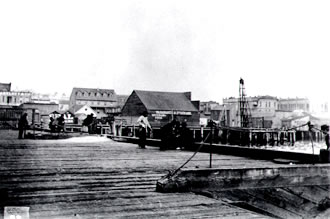
Chinese on a wharf in Port Townsend, (left). (Special Collections, University of Washington, Social Issues Files Cb, neg. 5074)
Interestingly, not all white communities in the Pacific Northwest reacted so violently against the Chinese. The anti-Chinese movement certainly touched Port Townsend, Washington, on the Strait of Juan de Fuca, but it had a different outcome there. The community decided at one point in early 1886 to attempt to remove its Chinese population, particularly as many were arriving from towns on Puget Sound from which they had been expelled. But whites tried to proceed against the Chinese in a more lawful fashion, by boycotting their businesses and firing them from jobs in white-owned businesses. These methods did not work, however, in part because white employers and consumers came to realize how much they depended on Chinese labor for the smooth running of the town economy. Moreover, contrary to the perception that Chinese sojourners sent all their earnings home, white leaders in Port Townsend came to understand that the Chinese had invested a considerable amount of money in the town itself. To expel the Chinese, then, was to create significant economic problems for the community. Port Townsend never went about integrating the Chinese socially into the community, and over time the population of Asian immigrants there dwindled as a result. (The town was also the site of considerable smuggling of Chinese into the United States from Canada after the 1882 exclusion.) But at least some white people in Port Townsend recognized the economic contributions that the Chinese made, and this recognition likely prevented in Port Townsend an expression of the kind of unrestrained hostility that had been unleashed elsewhere. [Daniel Liestman, 'The Various Celestials among Our Town': Euro-American Response to Port Townsend's Chinese Colony, Pacific Northwest Quarterly 85 (July 1994):93-104.]
| Course Home | Previous Lesson | Next Lesson |